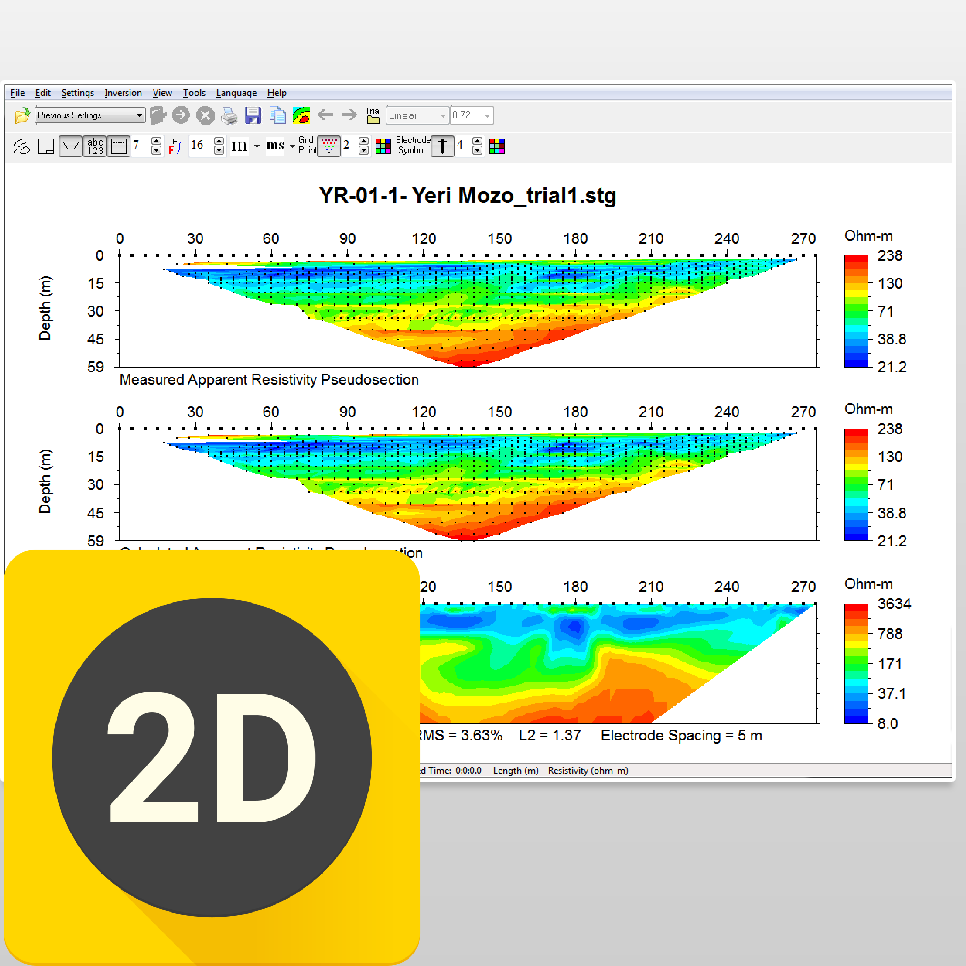3d Resistivity Inversion Software Testing
ERTLab™ is the 3D resistivity and chargeability inversion software that has radically changed the approach to electrical resistivity tomography (ERT) surveys, allowing full flexibility in the three-dimensional arrangement of the electrodes and creating the market of resistivity surveys around buildings. Available for both 32 and 64 bits platforms (with multi-threading capabilities), ERTLab™ is able to invert ERT measurements for any array geometry - surface, cross-hole or surface-to-hole. ERTLab™ makes use of Finite Elements algorithm for the accurate modeling of the terrain topography. Improve the way you perform resistivity and broaden the application of ERT surveys to new markets. Invert faster and manage huge sets of electrodes and measurements. Request a DEMO version. For the American market please refer to our partner and co-developer.
- 1.3 1-D resistivity surveys and inversion. 8 3-D Electrical Imaging Surveys 95. 3.1 The output from the RES2DMOD software for the.
- 3D ELECTRICAL RESISTIVITY TOMOGRAPHY INVERSION SOFTWARE. ERTLab Solver is the resistivity and IP inversion module that offers full three-dimensional topographical.
For People's Republic of China market please refer to our distributor. Supported OS Windows XP, 7, 8, 10 - 32 and 64 bits Multi-threading. Processing algorithms Tetrahedral Finite Elements forward modeling. Smoothness constrained Least Squares inversion.
The latest version of 3D UTAPWeLS. Resistivity Inversion Module. Click here to download a guideline for the Formation Testing using the Point Probe Tool.
Robust inversion with data reweighting algorithm. Features ERTLab ™ Solver. Multiple raw data formats import (MPT data, IRIS bin, ABEM txt and amp, AGI stg, PASI txt, MAE tsv, ARES, Siber.). Advanced pre-processing tools: statistical analysis, measurements reordering and filtering, pseudo-plots, reciprocals check, TX vs RX crossplots. Flexible mesh generation tools: easy topography import, variable cells size, multiple boundary conditions, update electrode elevations from DTM, stratigraphic layers insertion. User defined or file imported starting model. Smoothness constrained Least Squares inversion.
Data reweighting robust inversion. Flexible setting of the number of threads to use for processing. Survey design tools for the design of the electrode geometry, resistivity/chargeability forward modeling, synthetic data inversion and sensitivity analysis. Export of inverted models into open formats for displaying results into 2D and 3D graphical tools (Surfer, Voxler, MVS-EVS.). ERTLab ™ Viewer. Display sections in any direction of the space. Three different modes to represent sections: contours (automatic or user-defined), cell scalars and node scalars.

Plumes extraction (volumes). Isosurface extraction.
Multiple colormaps (rainbow, ultrajet or red-blue, linear or logarithmic, regular or inverted). Transparency, clipping on/off option, ortographic/perspective view.
Change axes properties, labels editing. Export in bitmap format. Load/save script files with session settings. Plot data from two files after performing mathematical operations between them for comparing models in time-lapse surveys. ERTLab ™ Sequencer.
User-friendly interface to insert electrodes and cables. Practical 3D view managing of the inserted objects. Mouse controlled selection of the electrodes to be skipped or to be used in roll-along mode. Sequence generator for 2D and 3D surface, borehole or surface-to-hole surveys. Special environment for cross-cable and multi-borehole sequence generation. Option to create mixed arrays by appending multiple sequences. Geometric factor constraining.
Pseudomaps for displaying measurements coverage. Multi-chnnel receivers optimization. Reciprocal quadrupoles generation.
Water Resistivity Testing
Multiple export formats (Electre II, ERTLab Solver, MPT Das, MAE, ARES, text.). Special and custom releases ERTLab64 multisource is the special ERTLab release that allows multisource datasets processing (n trasmitters for one Vmn receiver). ERTLab is customizable: we implement customized versions of the interface or of the numerical routines for customers with special processing needs related to specific markets (mining, engineering.).
ARES II - ARES II represents a well equipped resistivity and IP imaging system. Its advantages can be applied especially for large 2D and 3D surveys (operating up to 65,000 electrodes), for continuous survey from water level and for programable monitoring of structures. Groundwater exploration, geotechnical investigation, monitoring of dams and dikes, environmental studies, geological survey, mineral prospecting, archaeology, detecting of cavities and buried objects, underwater, marine, borehole and cross-hole measurements. JS-6A - Transmitter² oneboard computer control; accurate timing,high reliability² Large LCD, English menu, digital display ofoutput voltage, current, power supply resistance,power supply time, power supply period, thebattery voltage.² Big power supply current,overload protection² Big output voltage(1000V)MAIN SPECIFICATION:Time control Precision. EarthImager 3D - AGI is proud to introduce the new EarthImager 3D resistivity and IP inversion software.

This software inverts resistivity and IP data acquired with electrodes arranged in boreholes and/or on the surface and presents a 3D volume of inverted resistivity data with advanced volume rendering technique. The final resistivity or IP image-volume can be rotated in any orientation, zoomed in and out, and translated to anywhere inside the image window in order to see the volume of interest in detail. Colors representing areas of less interest can be made transparent so that the shape of a pollution plume, for example, can be visible.

With EarthImager, 3D resistivity inversion can be as easy as two steps: Read Data and Start Inversion with only a few mouse clicks. RES2DINV - designed to interpolate and interpret field data of electrical geophysical prospecting (2D sounding) of electrical resistivity (conductivity) and induced polarization.
The inversion of the resistivity and IP data is conducted by least-square method involving finite-element and finite-difference methods. The software can handle data from any electrode array, including Wenner (a, b, g), dipole-dipole, inline pole-dipole, pole-pole, Wenner-Schlumberger, equatorial pole-dipole and non-conventional arrays. Interpolate data from land, under water, and cross-borehole surveys.
Comments are closed.